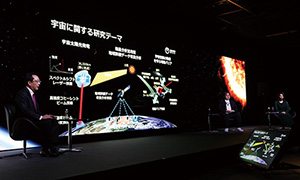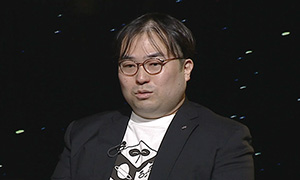 |
|
|
|
|
|
Feature Articles: NTT R&D Forum 2020 Connect Special Sessions Vol. 19, No. 3, pp. 16–18, Mar. 2021. https://doi.org/10.53829/ntr202103fa2  Challenges of NTT Space Environment and Energy Laboratories in the Coming Space MillenniumAbstractOn November 20th, 2020, special session 2 of NTT R&D Forum 2020 Connect was held and live streamed. The session welcomed novelist Yuya Takashima, the science fiction consultant for °»Mobile Suit Gundam THE ORIGIN°… and the multitalented entertainer Kaori Manabe as guests. The author, Yuji Maeda, vice president of NTT Space Environment and Energy Laboratories moderated the session on the theme °»Challenges of NTT Space Environment and Energy Laboratories in the Coming Space Millennium.°… Various research challenges tackled by the Laboratories, such as optimal operation technology for fusion reactors, were introduced while referring to the world in which the science-fiction work Gundam is set. Keywords: space, energy, environmental issue 1. IntroductionNTT Space Environment and Energy Laboratories was newly established as part of the Information Network Laboratory Group in July 2020. Under the basic concept of “Beyond our planet. Beyond our future.”, we aim to contribute to the regeneration of the global environment and creation of a sustainable and inclusive society. To this end, we are conducting research to develop next-generation energy technologies, such as nuclear fusion and space solar power systems, technologies that enable resilient environmental adaptation, and technologies to help achieve zero environmental impact. More specifically, the Laboratories includes the following groups: the Next-Generation Energy Technology Group, which researches overwhelmingly clean energy, such as fusion reactors and space solar power systems, as part of the Zero Environmental Impact Research Project; the Energy Network Technology Group, which researches distribution systems of the generated energy; the Sustainable Systems Group, which researches sustainable systems that reduce emissions of carbon dioxide; the ESG Management Science Technology Group, which scientifically analyzes environmental, social, and governance (ESG) management for predicting the future as part of the Resilient Environmental Adaptation Research Project; and the Proactive Environmental Adaptation Technology Group, which researches physically adapting ourselves to the environment and controlling the climate. 2. “Space Millennium” and the world of GundamThe first theme of special session 2 of NTT R&D Forum 2020 Connect was “The ‘Space Millennium’ and the world of Gundam.” I asked the question, “Will Gundam ‘mobile suit’ be necessary for the Earth in the future?” In response, novelist Yuya Takashima, who was involved in the Japanese manga and animation “Mobile Suit Gundam THE ORIGIN” as the science-fiction consultant, cited “mobile workers” as an example. As the predecessor of the “mobile suit,” mobile workers, which appeared in “Mobile Suit Gundam THE ORIGIN,” are humanoid machines created for lunar development work and can be considered highly advanced versions of a powered suit (also known as powered exoskeleton) currently being developed in the actual world. He said, “I personally think that it would be beneficial if we had something like mobile workers that enable us to move freely in outer space.” Multitalented entertainer Kaori Manabe pointed out the prospect that “If virtual reality technology becomes more advanced, there will be advantages that exceed the five senses.” She also said, “Mobile suit is supposed to be worn by humans, however, if communication technology develops, it will be possible for people to not only go into space for real but also, for example, go there by feelings only.” I responded, “A world in which robots can be sent alone into outer space and be operated from the Earth is fantastic.” and concluded, “We are doing our best to complete our mission to eliminate the world in which communication is not possible, including space communication.” After that, as a problem facing the current global environment, I pointed out that the population of the Earth has already increased too much and is expected to increase further, and asked their opinion about the migration of humans to a “space colony” as a realistic solution. Responding with “I want to go, too!”, Mr. Takashima said, “I have an image of staying in a space colony for the long term, which is depicted in Gundam.” In response, Ms. Manabe said, “Although we assume that people in a space colony will live the same life as those on Earth, it may be possible, for example, for the body only to exist in the space colony and the mind to live in a virtual world that differs in terms of life and consciousness.”
3. The “Space Millennium” and global environmental issuesThe second theme was “The Space Millennium and Global Environmental Issues.” I started by introducing the challenges NTT Space Environment and Energy Laboratories is undertaking. We are currently researching optimal operation technology for fusion reactors in collaboration with the International Thermonuclear Experimental Reactor (ITER) and the National Institutes for Quantum and Radiological Science and Technology. To extract energy from a fusion reactor, it is necessary to generate a plasma and keep it stable for a long time. Therefore, it is necessary to transfer a huge amount of sensor data from a reactor to the control center, calculate optimum values, and provide instant feedback to the reactor. To implement that process, it is essential to further increase the speed and reduce the latency of the network. Accordingly, NTT wants to contribute to this implementation by using Innovative Optical and Wireless Network (IOWN) technology. 4. Space solar power systemsWe are also researching space solar power systems, with which energy generated in geosynchronous orbit is transmitted over 36,000 km to the ground. I think if the laser used for that power transmission is developed, it could also be used to control the weather by warming and cooling clouds and the oceans. We aim to roll out the laser in the real world after carrying out various simulations on the Earth reproduced in cyberspace by using Digital Twin Computing technology and confirming that the laser has no adverse effects on the Earth or people. 5. Concluding remarksFinally, I asked both guests about what they would request NTT Space Environment and Energy Laboratories to pursue. Mr. Takashima requested that we conduct research on warp technologies. I replied, “It’s a different story when it comes to transporting the human body, but I think warp will be a technology in the field of communications,” leaving room for the possibility of the Laboratories entry into research on that topic. Ms. Manabe requested “to continue researching in directions that enrich the natural world by having both the values of a new technology and nature.”
|
|











